Surgical Treatment of Low-Lying Rectal Cancer: Updates
- PMID: 34961303
- PMCID: PMC8717072
- DOI: 10.3393/ac.2021.00927.0132
Surgical Treatment of Low-Lying Rectal Cancer: Updates
Abstract
Despite innovative advancements, distally located rectal cancer remains a critical disease of challenging management. The crucial location of the tumor predisposes it to a circumferential resection margin (CRM) that tends to involve the anal sphincter complex and surrounding organs, with a high incidence of delayed anastomotic complications and the risk of the pelvic sidewall or rarely inguinal lymph node metastases. In this regard, colorectal surgeons should be aware of other issues beyond total mesorectal excision (TME) performance. For decades, the concept of extralevator abdominoperineal resection to avoid compromised CRM has been introduced. However, the complexity of deep pelvic dissection with poor visualization in low-lying rectal cancer has led to transanal TME. In contrast, neoadjuvant chemoradiotherapy (NCRT) has allowed for the execution of more sphincter-saving procedures without oncologic compromise. Significant tumor regression after NCRT and complete pathologic response also permit applying the watch-and-wait protocol in some cases, now with more solid evidence. This review article will introduce the current surgical treatment options, their indication and technical details, and recent oncologic and functional outcomes. Lastly, the novel characteristics of distal rectal cancer, such as pelvic sidewall and inguinal lymph node metastases, will be discussed along with its tailored and individualized treatment approach.
Keywords: Lymph node excision; Proctectomy; Rectal neoplasms; Surgical procedures.
Conflict of interest statement
No potential conflict of interest relevant to this article was reported.
Figures
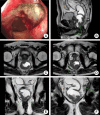

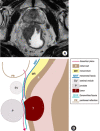





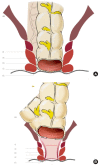


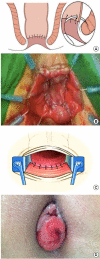



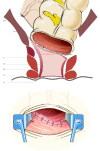



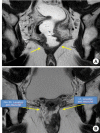


Similar articles
-
Critical and Challenging Issues in the Surgical Management of Low-Lying Rectal Cancer.Yonsei Med J. 2018 Aug;59(6):703-716. doi: 10.3349/ymj.2018.59.6.703. Yonsei Med J. 2018. PMID: 29978607 Free PMC article. Review.
-
[Rectum-preserving surgery after consolidation neoadjuvant therapy or totally neoadjuvant therapy for low rectal cancer: a preliminary report].Zhonghua Wei Chang Wai Ke Za Zhi. 2020 Mar 25;23(3):281-288. doi: 10.3760/cma.j.cn.441530-20200228-00096. Zhonghua Wei Chang Wai Ke Za Zhi. 2020. PMID: 32192308 Chinese.
-
[Short-term efficacy of robotic-assisted total mesorectal excision with and without lateral lymph node dissection for mid-low advanced rectal cancer: a propensity score matching analysis].Zhonghua Wei Chang Wai Ke Za Zhi. 2020 Apr 25;23(4):370-376. doi: 10.3760/cma.j.cn.441530-20190725-00289. Zhonghua Wei Chang Wai Ke Za Zhi. 2020. PMID: 32306605 Chinese.
-
Robotic versus laparoscopic sphincter-saving total mesorectal excision for mid or low rectal cancer in male patients after neoadjuvant chemoradiation therapy: comparison of long-term outcomes.J Robot Surg. 2020 Jun;14(3):393-399. doi: 10.1007/s11701-019-01001-5. Epub 2019 Jul 16. J Robot Surg. 2020. PMID: 31313071
-
[Surgical therapy of rectal carcinoma].Chirurg. 2003 Oct;74(10):905-14. doi: 10.1007/s00104-003-0735-2. Chirurg. 2003. PMID: 14605732 Review. German.
Cited by
-
Multidisciplinary Treatment Strategy for Early Colon Cancer: A Review-An English Version.J Anus Rectum Colon. 2022 Oct 27;6(4):203-212. doi: 10.23922/jarc.2022-046. eCollection 2022. J Anus Rectum Colon. 2022. PMID: 36348951 Free PMC article. Review.
-
The watch-and-wait strategy versus radical resection for rectal cancer patients with a good response (≤ycT2) after neoadjuvant chemoradiotherapy.Ann Surg Treat Res. 2022 Dec;103(6):350-359. doi: 10.4174/astr.2022.103.6.350. Epub 2022 Dec 8. Ann Surg Treat Res. 2022. PMID: 36601336 Free PMC article.
-
Risk factors influencing sphincter preservation in laparoscopic radical rectal cancer surgery.World J Gastrointest Surg. 2025 Mar 27;17(3):101061. doi: 10.4240/wjgs.v17.i3.101061. World J Gastrointest Surg. 2025. PMID: 40162401 Free PMC article.
-
Clinical using of innovative biodegradable stent with extension sleeve in Ta_tme for low rectal cancer with high risk of anastomotic leakage.Sci Rep. 2025 Feb 25;15(1):6797. doi: 10.1038/s41598-024-73935-2. Sci Rep. 2025. PMID: 40000647 Free PMC article.
-
Unlocking the in vivo therapeutic potential of radiation-activated photodynamic therapy for locally advanced rectal cancer with lymph node involvement.EBioMedicine. 2025 Jun;116:105724. doi: 10.1016/j.ebiom.2025.105724. Epub 2025 May 12. EBioMedicine. 2025. PMID: 40359628 Free PMC article.
References
-
- Church JM, Raudkivi PJ, Hill GL. The surgical anatomy of the rectum: a review with particular relevance to the hazards of rectal mobilisation. Int J Colorectal Dis. 1987;2:158–66. - PubMed
-
- Bogach J, Tsai S, Zbuk K, Wong R, Grubac V, Coates A, et al. Quality of preoperative pelvic computed tomography (CT) and magnetic resonance imaging (MRI) for rectal cancer in a region in Ontario: a retrospective population-based study. J Surg Oncol. 2018;117:1038–42. - PubMed
-
- Zhou Y, Shao W, Lu W. Diagnostic value of endorectal ultrasonography for rectal carcinoma: a meta-analysis. J Cancer Res Ther. 2014;10 Suppl:319–22. - PubMed
Publication types
LinkOut - more resources
Full Text Sources

